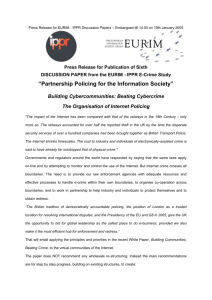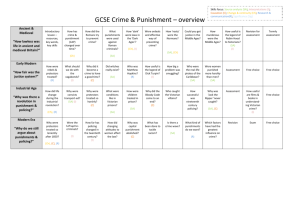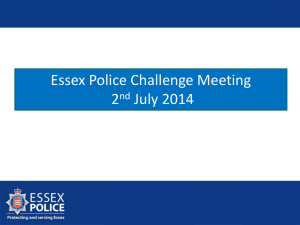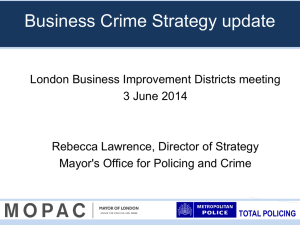Crime mapping and the neighbourhood David Ashby
advertisement
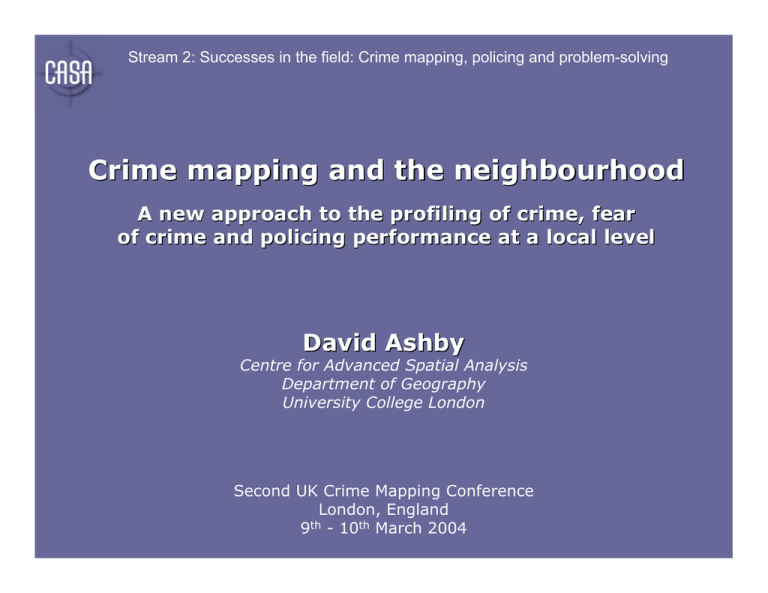
Stream 2: Successes in the field: Crime mapping, policing and problem-solving Crime mapping and the neighbourhood A new approach to the profiling of crime, fear of crime and policing performance at a local level David Ashby Centre for Advanced Spatial Analysis Department of Geography University College London Second UK Crime Mapping Conference London, England 9th - 10th March 2004 Outline • Crime mapping for strategic policing • Public service reform agenda and the geographies of policing / performance assessment • Geodemographics • Recorded crime profiles • British Crime Survey profiles Tactical, operational crime mapping and management Strategic, local-community based initiatives Police Reform • Mantra of the moment; the local, the neighbourhood, community policing, reassurance policing, citizen focus-policing. • Police performance (measurement) culture • Spottiswoode Report • Best Value (PI’s and PP’s) • Police Performance Assessment Framework • Dichotomy of local and national priorities • Increased accountability I am absolutely certain that the safer neighbourhood teams will deliver. We have had enormous support from the Home Secretary – particularly in the shape of the modernisation of our communications processes known as C3i, for which we have received a special grant of £140 million, the largest in the history of policing – and all political parties, Labour, Conservative and Liberal Democrat are engaged in a dialogue about localism, about accountability and all seem immensely supportive of our Step Change programme. Sir Ian Blair Policing Performance Assessment Framework the ‘domains’ of policing Performance monitors City of London City of London Dyfed-Powys Dyfed-Powys PPAF development Most Similar Forces revisited Two-years data but still only 13 indicator variables Disclaimers about City of London, etc Most Similar Force peer group charts Mapping Most Similar Forces results from PPAF? Benchmarking performance • Massive variation in policing environments (rural, urban, affluent, deprived, demography, location, etc…). • Assessing comparative performance should reflect different crime & policing challenges/environments. • Policing priorities, strategies, resource allocation and evaluation should be on a like-with-like basis; i.e. accounting for the differences between areas. • Move away from national league tables in favour of comparing ‘similar’ areas. • Most Similar Forces and Fixed Families (BCU / CDRP) OR…go ‘local’ Spatial granularity Different zones are built using postal geography provided the Royal Mail Postcode NG34 5AH 1.6 million postcodes 15 households in each Postal Sector NG34 5 9,000 sectors 2,600 households in each Postal District NG34 2,700 districts 8,600 households in each Postal Area NG 120 areas 194,000 households in each F: Welfare Borderline 37: Upper Floor Families 36: Metro Multiculture E: Urban Intelligence 32: Dinky Developments Geodemographics • Area typologies that are powerful discriminators of behaviour and aid market analysis ~ Small area demographic analysis • Clusters similar neighbourhoods into lifestyle categories • Social similarity rather than locational proximity (administrative areal units) • Growth of interest from mid 1980s • ACORN, GB Profiler, Mosaic, Cameo • Charles Booth’s 1889 London Poverty Map Booth’s classification Colour Description BLACK Lowest class. Vicious, semi-criminal. DARK BLUE Very poor, casual. Chronic want. LIGHT BLUE Poor. 18s. to 21s. a week for a moderate family PURPLE Mixed. Some comfortable others poor PINK Fairly comfortable. Good ordinary earnings. RED Middle class. Well-to-do. YELLOW Upper-middle and Upper classes. Wealthy. Mosaic UK classification • Approximately 400 data variables used in Mosaic UK • Census 2001 accounts for 54% of input data • Experian Consumer Segmentation Database – 46 million adult residents & 23 million households • • • • • • • Electoral Roll Experian Lifestyle Surveys Consumer Credit Activity Post Office Address File Shareholders Register House Price and Council Tax information ONS local area statistics Geodemographics for policing Geodemographic typologies can help the police and other public services to: – understand more about their ‘customers’ – focus policing activities (resource determination) – customise communication to different target markets – predict what policing and crime reduction strategies will be effective in whichever area is chosen, locally and internationally – evaluate neighbourhood policing styles and public satisfaction at a local level A03 : Symbols of Success / Corporate Chieftains Uphill Road, Mill Hill, NW7 4RB Bridge of Weir Road, Kilmacolm, PA13 4NU Rosebery Avenue, Harpenden, AL5 2QT Northwold Road, Bolton, BL1 5BH D24 : Ties of Community / Coronation Street Cumberland Street, Wallsend, NE28 7SB Coronation Street, Carlin How, Loftus, TS13 4DN Albert Street, Mexborough, S64 9BT Elliott Street, Preston, PR1 7XN F38 : Welfare Borderline / Tower Block Living Thornbush Road, Airdrie, ML6 6RR Landos Road, Manchester, M40 7HY Chipperfield Road, Birmingham, B36 8SD Charles Street, Glasgow, G21 2PX J54 : Grey Perspective / Bungalow Retirement Nottingham Road, Clacton on Sea, CO15 5PG Hazeldown Road, Teignmouth, TQ14 8QR Fife Road, Herne Bay, CT6 7RE Haysom Close, New Milton, BH25 6PN K60 : Rural Isolation / Pastoral Symphony Wern Ddu, Tyn y Groes, Conwy, LL32 8SS Lumburn, Tavistock, PL19 8HT Melmerby, Penrith, CA10 1HF Dalemoor Farm, Dale, Ilkeston, DE7 4PH A01: Global Connections E28: Counter Cultural Mix F36: Metro Multiculture Relative incidence of young offender offences per 1000 households % HH Mosaic Group Index 6.82 A : Symbols of Success 27 8.30 B : Happy Families 43 14.62 C : Suburban Comfort 29 22.55 D : Ties of Community 98 6.33 E : Urban Intelligence 106 6.68 F : Welfare Borderline 209 9.91 G : Municipal Dependency 257 12.03 H : Blue Collar Enterprise 153 4.61 I : Twilight Subsistence 30 5.51 J : Grey Perspectives 25 2.64 K : Rural Isolation 38 Calculating profiles Recorded Crime data • North and East Devon BCU • 1999 – 2000 crime incident data • Victim, offender and location postcodes • 26,848 records British Crime Survey • Criticisms of recorded crime data include: • • • • • Decision to report (under-reporting) Attrition: call centres, control rooms Police crime recording practices Performance Assessment Attitudinal data – fear, social capital,… …the real picture of crime? • Problems with and criticisms of the BCS: • • • • • Retail crime Youth crime (under 18s) Repeat victimisation Not large enough to pick up rare events Lacks local context British Crime Survey • Collaboration with National Centre for Social Research (NatCen). • Coded BCS 2000 responses to unit postcode level; Mosaic neighbourhood types/groups • Profiles cover a range of topics – crime type – causes of crime – fear of crime – neighbourhood satisfaction – Anti-social behaviour / disorder – attitudes towards the police and CJS • New profiles on fire and car crime, and segmented by ethnicity, gender and rurality/accessibility Appropriate policing styles David I. Ashby Researcher Centre for Advanced Spatial Analysis University College London 1-19 Torrington Place London WC1E 7HB T: +44 (0) 20 7679 4287 F: +44 (0) 20 7813 2843 E: d.ashby@ucl.ac.uk W: http://www.casa.ucl.ac.uk/ashby
